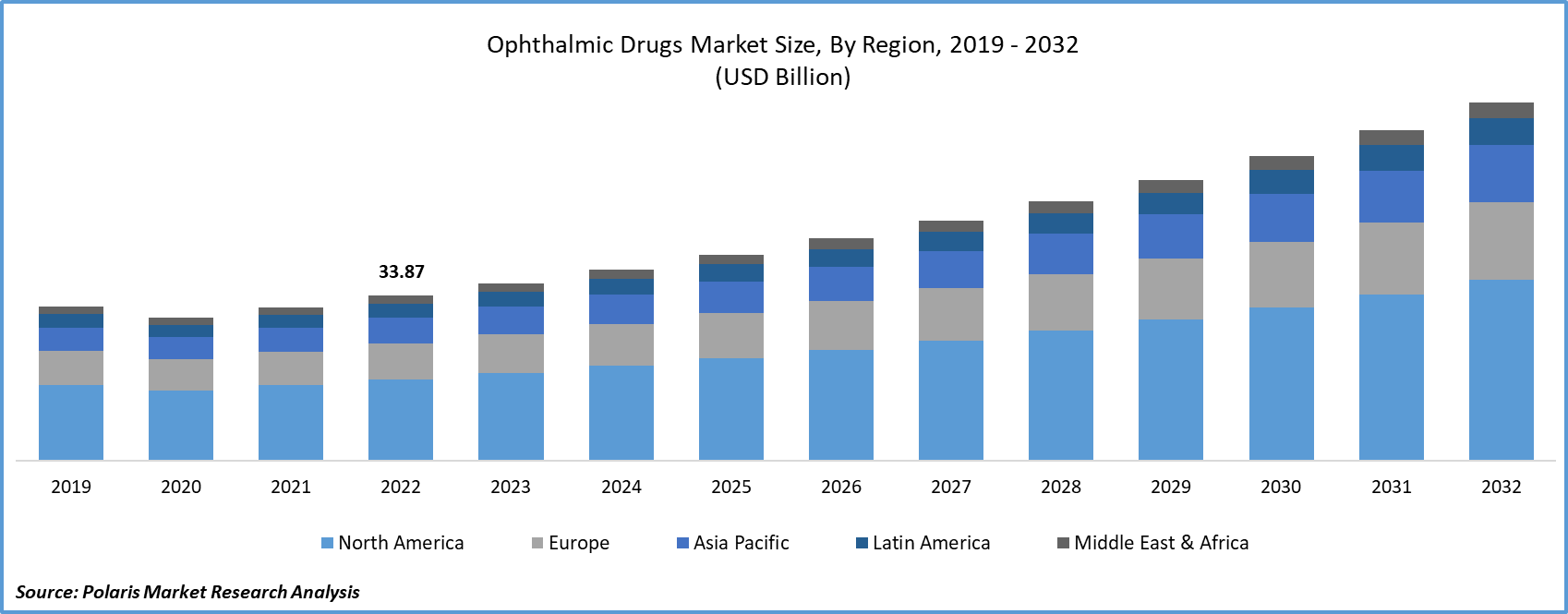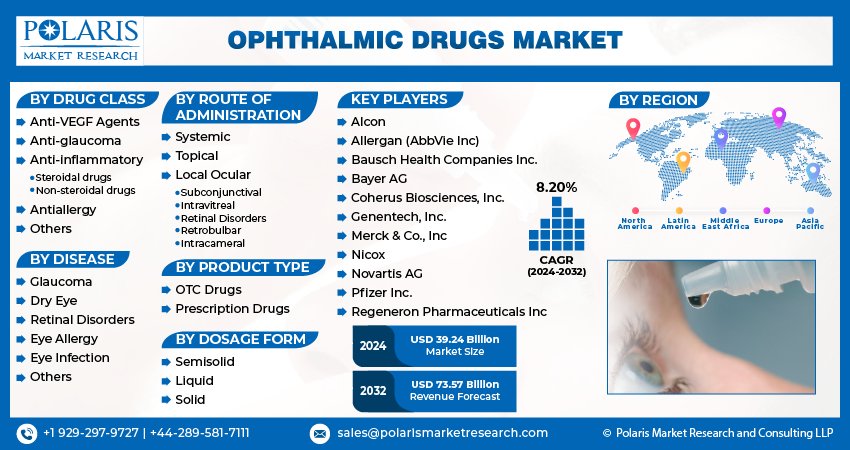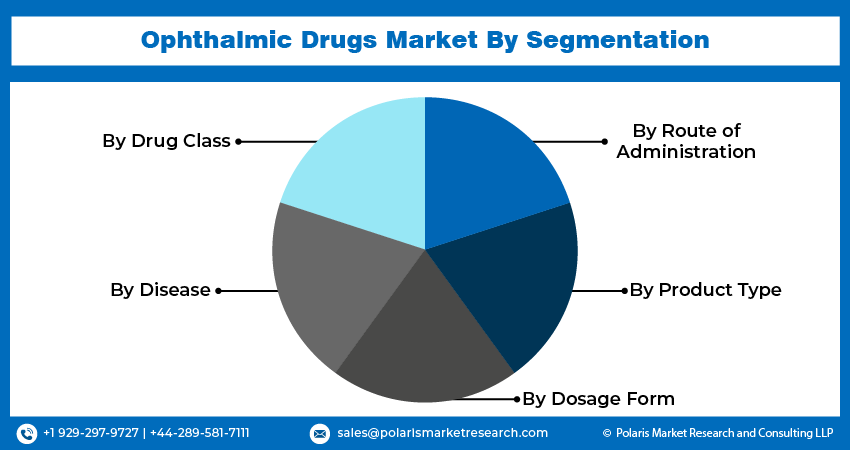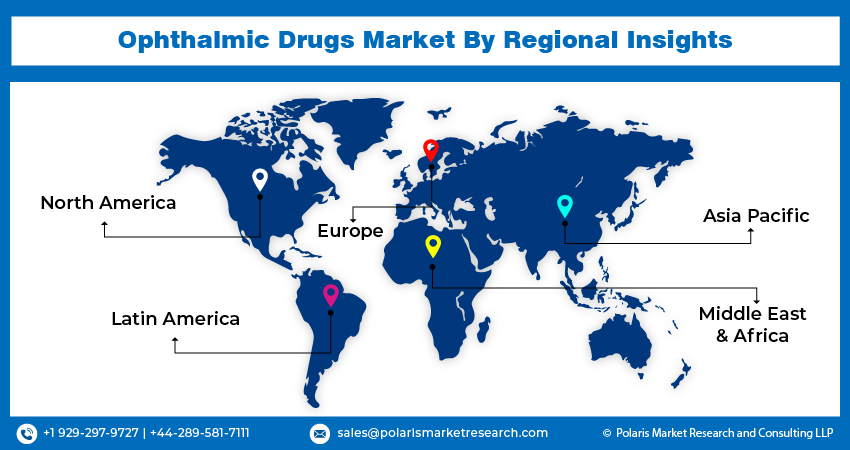
Ophthalmic Drug Market Share, Size, Trends, Industry Analysis Report, By Drug Class (Anti-VEGF Agents, Anti-glaucoma, Anti-inflammatory, Antiallergy, Others); By Disease; By Route of Administration; By Product Type; By Dosage Form; By Region; Segment Forecast, 2024 - 2032
- Published Date:Jan-2024
- Pages: 116
- Format: PDF
- Report ID: PM4073
- Base Year: 2023
- Historical Data: 2019-2022
Report Outlook
The global ophthalmic drug market was valued at USD 36.44 billion in 2023 and is expected to grow at a CAGR of 8.20% during the forecast period.
The expected surge in research and development activities directed towards the creation and introduction of innovative ophthalmic drugs, in combination with various strategic initiatives envisioned by key industry players, is poised to stimulate market demand. Furthermore, the unaddressed requirements within the realm of ophthalmology are likely to fuel the expansion of the ophthalmic drug market. As per a report by the World Health Organization in October 2021, an estimated 2.2 billion individuals grapple with vision impairments, encompassing both nearsightedness and farsightedness. Notably, around half of these cases, accounting for at least 1 billion instances, can be prevented through suitable treatment. Age-related factors predominantly underpin the leading causes of blindness and vision impairments. This heightened prevalence places a considerable financial burden on governments, with myopia alone estimated to cost as much as USD 244 billion in terms of vision impairment. Consequently, due to the rising incidence of eye-related disorders, the ophthalmic drug market is poised to encounter promising growth opportunities.
Ophthalmic drugs are pertained to the eye or adjoining tissue. Drugs for ocular management surface in several configurations involving solutions, ointments, suspensions, and gels and can be utilized to distribute an active pharmaceutical ingredient (API) to the exterior of the eye, within the eye, near to eye, or they can be utilized with an ophthalmic device. There is an aggregate of ophthalmic preparations obtainable over the counter for extensive sales, with the majority offering a cure for dry eye or redness.
A triumphant ophthalmic articulation must encounter several criteria. It requires to be secure and productive. The ophthalmic drug market size is expanding as it should also be steady in repository and shipment with an extended shelf life. Preferably, its configuration will be prudent and bearable to patients. In context to security, ophthalmic drugs are parenteral commodities, and as such, they require to be liberated from all microorganisms; all ocular commodities must live through a sterility test to sanction that they entail no pyrogens.

To Understand More About this Research: Request a Free Sample Report
The anticipated growth of the ophthalmic drugs market during the forecasted period is driven by the increasing research and development efforts and investments made by major industry players.
- For instance, Alcon, a prominent player in the field of eye care, substantially increased its R&D expenditure from USD 673 million in 2020 to USD 842 million in 2021. Alcon boasts a diverse product portfolio, encompassing contact lenses, cataract treatments, and glaucoma products.
Furthermore, the presence of a robust pipeline of promising drug candidates is expected to facilitate market expansion further.
- For instance, Nicox, an emerging eye therapeutics company, is currently in Phase III trials with its investigational candidate NCX 470, a novel prostaglandin analog that releases nitric oxide. This innovative product is anticipated to enter the market by 2029.

Industry Dynamics
Growth Drivers
- Propelled by increasing clinical trials and pipeline candidates, demand for innovative drugs and therapies is on the rise
The escalating prevalence of ophthalmic diseases in the population is a key factor fueling the growing demand for effective treatments. Consequently, there is an increasing emphasis from both market players and research organizations on developing and introducing innovative therapies for these conditions.
The heightened dedication of ophthalmic drug market players to research and development activities geared toward creating novel therapies for these ailments is anticipated to generate significant demand for ophthalmic disease treatments in the market throughout the forecast period. The intensified commitment and substantial efforts by key industry players to devise and release groundbreaking therapies to address the unmet needs of the growing patient population are expected to drive the consumption of ophthalmic drugs.
ClinicalTrials.gov currently includes about 44 potential treatments for macular degeneration in the advanced phase III clinical trials.
For instance, In November 2022, Santen Pharmaceutical Co., Ltd. unveiled DIQUAS LX, a 3% ophthalmic solution specifically formulated for the treatment of dry eye.
As a result, the increasing number of patients seeking treatment, coupled with the rising approvals and launches of innovative drugs and therapies, is poised to stimulate market growth during the forecast period.
Report Segmentation
The market is primarily segmented based on disease, drug class, route of administration, dosage form, product type, and region.
|
By Drug Class |
By Disease |
By Route of Administration |
By Product Type |
By Dosage Form |
By Region |
|
|
|
|
|
|
To Understand the Scope of this Report: Speak to Analyst
By Drug Class Analysis
- The Anti-inflammatory segment held the largest revenue share in 2022
The Anti-inflammatory segment held the largest revenue share in 2022 owing to the factors like the expanding number of patients receiving treatment for ocular allergies and inflammation.
The Anti-VEGF segment is poised to exhibit a substantial CAGR throughout the forecast period. The increasing prevalence of retinal disorders such as diabetic retinopathy, age-related macular degeneration, and others, coupled with a rising rate of diagnosis for these conditions in the population, is driving the growing demand for anti-VEGF therapy in various regions. For instance, according to the CDC, approximately 20.0 million Americans were affected by age-related macular degeneration, and the global figure is projected to reach 288 million by 2040.
Furthermore, the increasing number of product approvals and launches is contributing to the segment's global growth. For instance, In January 2022, Genentech, Inc., a subsidiary of F. Hoffmann-La Roche Ltd., obtained approval from the U.S. FDA for Vabysmo, a treatment for wet, or neovascular, age-related macular degeneration and diabetic macular edema, targeting vascular endothelial growth factor.
Conversely, the surging prevalence of glaucoma, coupled with the increasing research and development initiatives of market players and their collaborative efforts to create and introduce anti-glaucoma treatments, is poised to foster growth in this market segment. For instance, In November 2022, Nicox SA, a global leader in ophthalmology, entered into a partnership with Ocumension Therapeutics to introduce NCX 47 to the market. NCX 47, a phase III candidate tailored to reduce intraocular pressure in open-angle glaucoma patients, is set to be made available in both the U.S. and Chinese markets.
The increasing rate of diagnosis of ocular infections and retinal diseases in the population is a pivotal factor contributing to the growing demand for the medication.
By Dosage Type Analysis
- The Semisolid segment accounted for the highest market share during the forecast period
The Semisolid segment is projected to achieve a higher CAGR, primarily due to the increasing approvals and product launches, encompassing ointments, suspensions, gels, and others. The expanded utilization of ointments, especially in addressing inflammatory conditions, infections, and dry eye, is contributing to their growing popularity, given their enhanced efficacy. Additionally, the segment's growth is further driven by the heightened focus of key industry players on obtaining approvals and introducing a wider range of products. For instance, In November 2021, I-MED Pharma Inc. introduced I-DEFENCE, a nighttime ointment for dry eye, to the U.S. market
The Liquid segment held the market's dominant position in 2022, primarily because of its widespread adoption among patients, attributed to several advantages such as ease of use, prolonged contact time between the product and the affected area, improved solubility, and more. The increasing prevalence of ophthalmic conditions and the growing number of patients seeking treatment through eye drops, eye solutions, and similar products are anticipated to drive the growth of this market segment.

Regional Insights
- North America dominated the largest market in 2022
The region's growth can be attributed to a higher prevalence of eye diseases and an increasing awareness of these conditions. Additionally, the ongoing research and development efforts of key industry players are expected to drive regional growth further. Furthermore, North America benefits from the presence of major players such as Pfizer Inc., Alcon, and Bausch and Lomb.
For instance, in June 2022, Harrow Health Inc. announced the commercial availability of MAXITROL and IOPIDINE 1% in the U.S. The introduction of new FDA guidelines under the Prescription Drug User Fee Act provides a structured framework for assessing the risks and benefits of clinical trials for these ophthalmic drugs.
Asia Pacific is poised to emerge as the swiftest-growing region in this context. The expansion in the Asia Pacific region can be attributed to several factors, including a substantial patient population, a high prevalence of eye diseases, and the emergence of local companies. Although the Asia Pacific region boasts the largest patient base, the treatment rate is comparatively lower in this area. Furthermore, the implementation of various strategic initiatives by market players is anticipated to contribute to regional growth.

Key Market Players & Competitive Insights
The market is characterized by intense competition, with established players relying on advanced technology, high-quality products, and a strong brand image to drive revenue growth. These companies employ various strategies such as research and development, mergers and acquisitions, and technological innovations to expand their product portfolios and maintain a competitive edge in the market.
Some of the major players operating in the global market include:
- Alcon
- Allergan (AbbVie Inc)
- Bausch Health Companies Inc.
- Bayer AG
- Coherus Biosciences, Inc.
- Genentech, Inc. (F. Hoffmann-La Roche Ltd)
- Merck & Co., Inc
- Nicox
- Novartis AG
- Pfizer Inc.
- Regeneron Pharmaceuticals Inc
Recent Developments
- In September 2022, Santen Pharmaceutical and UBE have received U.S. FDA approval for Omlonti, an eye drop solution for lowering intraocular pressure in individuals with glaucoma or ocular hypertension.
- In June 2022, F. Hoffmann-La Roche Ltd. has been granted approval by Health Canada for Vabysmo, an authorization for the treatment of neovascular (wet) Age-related Macular Degeneration (AMD) and Diabetic Macular Edema (DME).
- In April 2022, Sandoz, a subsidiary of Novartis, introduced its generic combination eye drops, consisting of brimonidine tartrate and timolol maleate, in an ophthalmic solution with a concentration of 0.2% and 0.5%, respectively. This generic medication is considered equivalent to AbbVie's COMBIGAN and is intended to reduce eye pressure in patients with ocular hypertension (high eye pressure) within the United States.
Ophthalmic Drug Market Report Scope
|
Report Attributes |
Details |
|
Market size value in 2024 |
USD 39.24 billion |
|
Revenue forecast in 2032 |
USD 73.57 billion |
|
CAGR |
8.20% from 2024 – 2032 |
|
Base year |
2023 |
|
Historical data |
2019 – 2022 |
|
Forecast period |
2024 – 2032 |
|
Quantitative units |
Revenue in USD billion and CAGR from 2024 to 2032 |
|
Segments Covered |
By Disease, By Drug Class, By Route of Administration, By Dosage Form, By Product Type, By Region |
|
Regional scope |
North America, Europe, Asia Pacific, Latin America; Middle East & Africa |
|
Customization |
Report customization as per your requirements with respect to countries, region and segmentation. |
